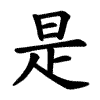是
- this;
- right, correct;
- to be;
- the copula “is”;
Etymology
Pictographic and later phono-semantic compound:
In bronze inscriptions (金文 jinwen), 是 was composed of 早 (조, “early / sun rising”) above 止 (지, “to stop, to stand”).
This likely symbolized the sun halting at its zenith, a metaphor for rightness, correctness, or being at the proper point.
Some scholars (notably 郭沫若 Guo Moruo) proposed that it originally depicted a ladle or spoon (匙) — an instrument for measuring and thus ensuring correctness.
In later clerical script (隸書), the upper part was reinterpreted as 日 (sun), and the lower element evolved toward 正 (correct), aligning graphically and semantically with “rightness.”
Thus, 是 evolved from a pictorial image of alignment or correctness into one of truth and affirmation.
Usage in Korean
시비 (是非) — right and wrong; dispute
시정 (是正) — to correct, to make right
시연 (是然) — affirmation, assent
시직 (是職) — rightful office or proper role
진시 (眞是) — truly is; completely correct
In modern Korean Sino-compounds, 是 retains the core meaning of “rightness” or “affirmation.”
It no longer functions as a grammatical copula (“이다”) in Korean, but this older function survives in Chinese and Japanese grammar.
Words that derived from 是
Additional notes
In modern Mandarin, 是 functions as the primary copula ("to be") and as an emphatic affirmative particle:
這是書。- This is a book.
我是學生。- I am a student.
是的。- Yes, that is correct.
Classical & historical notes:
In pre-Qin texts, 是 was primarily an adjective or demonstrative pronoun, meaning “this, right, proper.”
By the Han dynasty, it developed into a copular verb — the equivalent of the modern “to be” (be 동사) — a grammatical role that continues in modern Chinese.
Examples from classical literature:
「是非之心,人皆有之。」
“The sense of right and wrong is in all men.” — Mencius (孟子)
「學而時習之,不亦說乎?有朋自遠方來,不亦樂乎?人不知而不慍,不亦君子乎?是三者也。」
“To learn and constantly practice it, is this not joy? To have friends come from afar, is this not delight? To be unresentful when others do not know you, is this not the conduct of a gentleman? These three (是三者) are such.” — Analects (論語)
The usage of 是 as “this” or “right” gave rise to its philosophical and moral importance in Confucian ethics — the discernment of “是非” (rightness and wrongness) being a fundamental moral faculty.
Cultural & philosophical notes:
In Confucian and Mencian philosophy, 是 represents moral discernment and correctness — the ability to distinguish right (是) from wrong (非).
This capacity, called 是非之心 (the mind that knows right and wrong), is considered one of the Four Beginnings (四端) of human virtue.
「是其所是,非其所非,君子矣。」
“He who approves what is right and condemns what is wrong — he is a true gentleman.” — Xunzi (荀子)
In Buddhist texts, 是 functions in a more ontological sense — expressing affirmation of truth or existence (“thus it is,” 是法), akin to the Sanskrit tathā (“thus / so”).
For example, in the Heart Sutra (般若心經), phrases like “是諸法空相” (“these dharmas are of empty form”) employ 是 in its existential and affirmational sense.
Symbolic interpretation:
是 embodies rightness, affirmation, and existence — it signifies “that which is so.”
The evolution from demonstrative (“this”) → moral (“right”) → existential (“is”) traces a profound philosophical arc:
to point at truth, to recognize it, and finally, to affirm it.
「是者,真理之名也。」
“‘Is’ — the name of truth itself.”
In spiritual and linguistic terms, 是 bridges being and correctness, serving as both a word of truth and a word of existence.
- 日一卜人 (AMYO)
- ⿱ 日 𤴓
- ⿱ 旦 龰
